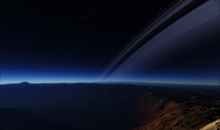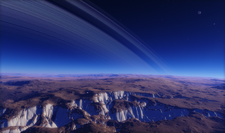
The planet of Coalescent. The rings, purple landscape, and bright-white craters stand out against the blackness of space.
Overview[]
Coalescent is a cold icy world located not too far from urban settlements and dense populations. It was discovered by a lone group of colonists, who wished to survey and catalogue the Florathel Galaxy. Coalescent was deemed uninhabitable due to its freezing temperatures, and an unbreathable atmosphere. However, some have still visited, and are charmed over its beautiful landscape, striking rings, and nine moons. Small domed colonies exist, but are infrequently manned with a sustainable amount of people.
Physical[]
Coalescent features stunning purple plains, tall frosty peaks, and deep frozen canyons. With a beautiful ring system that matches its features wonderfully, the surface of Coalescent is mostly brown with deep purple areas in both northern and southern hemispheres. These purple areas are the result of ammonium manganese(III) pyrophosphate, which has a natural purple appearance. Since it is not a naturally occurring compound, it is unknown how it could have formulated on the surface of Coalescent. Under the surface is a kilometer-thick layer of ice, which is exposed in areas like Draxel Canyon (see Fig. 2). The upper parts of the ice layer are water-ice, but in some deeper areas, the ice is composed of frozen carbon dioxide. Huge, bright white impact craters, preserved in the frozen crust, are another eye-catching aspect of Coalescent. Muscha, its largest crater, is the planet's most recent impact (see Fig. 1).

Fig. 1: Dusk has come upon one of the few areas of Muscha crater that isn't blindingly white.
Atmospherics[]
Coalescent's atmosphere is mainly composed of methane, acetylene, and carbon dioxide, giving the sky a deep blue tinge. Weather-wise, the only extreme events are seasonal ice storms. Meteorological probes sent early on by independent companies searching for resources have deduced most occur during a short period between the perihelion and aphelion of Coalescent's orbit. During the perihelion (the planet's closest approach to its parent star) the day temperatures rise high enough for any frozen carbon dioxide trapped near the surface to evaporate into the atmosphere. As the planet begins it's orbit away from the star and the temperature drops, the CO2 will begin to condense into clouds, until the critical temperature is reached where it beings to freeze into dry-ice crystals. At this point, the freezing CO2 falls from the sky in the form of "freezing" rain, dry-ice snow, or solid dry-ice globules. These globules can range in size from a small pebble to a more sizable rock. Most of these storms last from a few minutes to around 27 hours (the longest recorded event) with varying severity.
Ring System[]
Coalescent's rings are one of its most prominent features and compose of ammonium manganese(III) pyrophosphate, water-ice, rock, metals such as platinum, silver, and iron. The ammonium manganese(III) pyrophosphate in the rings gives them their signature lilac tinge, with the metallic dust and rocks yielding a spectacular dazzling shimmer when exposed to light. Again, it is unknown how the ammonium manganese(III) pyrophosphate could have possibly formed in the rings.

Fig. 2: Lilac rings streak across the sky as a lone exploration drone takes high-altitude pictures of the icy Draxel Canyon.
Inhabitants[]
Few dare to live on Coalescent. Although it may be beautiful, it lacks an appropriate temperature, atmosphere, and sustainable food. The only known inhabitant is the lone explorer who is believed to have discovered the planet. Some conspiracy theorists that he has figured out the key to forward and backward time travel, as he has been supposedly sighted across the galaxy at completely different time periods. Some sightings date all the way back to 53491 CE at the founding of the Cnara-Frealee Federation. The appearance of the explorer is a young man with barely visible brown hair. His features are constantly shielded by red-purple EEU (Extrasolar Exploration Unit), with a lavender scarf for no apparent purpose. It's been noted by several witnesses that he is also known to wear a highly advanced EEU helmet that (according to visual scans) currently does not exist as a civilian-available product. It's most likely his highly-advanced gear is for exploration in areas with more extreme conditions, explaining why he is able to thrive on the planet of Coalescent. Most sightings occur within or nearby what's known as Draxel Canyon, named after famed Carlean mathematician Mora Draxel. Some theorize that the explorer's habitat is built deep within the ice-glazed walls of the canyon. Extrasolar Projects has shown no interest in searching for this explorer, claiming it is of no importance and no apparent threat. However, others have piqued some interest across the galaxy by relating the explorer to the famed Traveler, a legendary man who has also harnessed the power of time travel using the black hole method. Hundreds of reports have claimed to sight the explorer with the Traveler, often having short conversations or trading unknown materials. Whether these reports are fabricated is unknown, but picture evidence since confiscated has been claimed to exist. Many compare the explorer to the Traveler but note that the explorer appears to roam around the galaxy at leisure more than for updating the technology of his equipment, which the Traveler is known for. It is theorized that the explorer's ship and suit technology is much more advanced than what is currently accessible, eliminating the need for updating. His ship is believed to be equipped with a highly advanced form of alcubierre drive, also known as a warp drive, letting him travel across the galaxy at speeds faster than that of the current wormhole-travel technology used - even though most warp drive technology was rendered obsolete after the discovery of wormholes. Some believe that the explorer chooses his technology not for the fact that it's more efficient, but rather that he can adjust his "speed" for more relaxing, longer journeys across the cosmos.
Satellites[]
Coalescent features 9 moons, each of them as cold and rocky as the first. Although none of them have proper names yet, nicknames describing their differences are thrown around. Coalescent's largest moon, nicknamed Ghost, is almost pure white for example.
